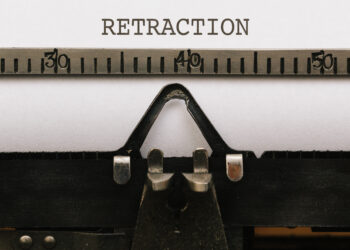
Most publishers are looking for ways to reduce or eliminate print costs. We live in an age where re-factoring print is part of the migration to digital for publishers with legacy businesses.
So I was slapping my forehead when I read about the American Chemical Society’s brilliant solution to reducing printing costs while satisfying authors, librarians, and (possibly) readers.
Their insight is what I like to call a “blinding flash of the obvious” — print two pages at once by flipping them landscape and reducing them to fit. It’s what ACS is calling “rotated and condensed.”
Brilliant. It’s how a lot of us print long PDFs to save paper.
I called up Journals Publishing Group VP Susan King to ask her about the change, which is planned to start in July. She told me her production director came up with the idea in a brainstorming session about how to reduce print costs.
The brilliance of the idea strikes at a few angles:
- Libraries receive archive-worthy, bindable print copies.
- Libraries reduce the amount of shelf space required to store journals from ACS.
- ACS saves mailing costs.
- The issues are arguably easier to browse in the two-up format, which relies on a page image 70% of full-size and more complete utilization of margins.
- Because of the savings, ACS can continue printing color without having to impose fees for color illustrations and images.
- Price increases are averted.
As Susan said in the Chemical & Engineering News story:
The transition from print to Web for ACS journals has now passed a tipping point.
I asked Susan whether they tested the new layouts with readers. She told me their focus groups were with librarians, and that the librarians approved, some citing improvements in scanning the materials. But she admitted they haven’t done focus groups or testing with readers. There might be an unpleasant surprise in reader reaction when they see the change, and I wonder why they didn’t test with readers before announcing it. But, then again, with the way print seems to be losing ground with readers in the basic sciences, I might have taken the same risk myself.
PDFs of articles from the ACS site will be formatted in the standard way — full-sized pages.
Of course, formatting pages landscape in the print issues forces readers to hold them up in a way reminiscent of men holding up centerfolds of magazines. This might make casual observers think the chemists are looking at something lurid when they’re just analyzing a particular chemical structure. There’s a certain ironic humor to that, I suppose.
And while the pages are going landscape, the covers are remaining portrait. It might have been nice to switch the whole book around to the landscape mode and set expectations from the start.
The reduction in page count also helps with shipping costs, cutting them in half. Susan told me that an annual print subscription to all ACS journals weighs in at more than one-half ton. Shedding 500 pounds of print per subscriber makes this a diet plan of awesome proportions.
Publishers have been busy shrinking print for years now, from publishing entire sections online to publishing abbreviated versions in print to eliminating sections completely. Print isn’t dying — it’s being eroded by waves of bandwidth taking over the landscape. Soon, instead of a continent, we’ll have islands.
As publishers and readers adjust to the new digital scholarly communication paradigm, finding painless ways to take away familiar pieces will be important. The ACS’ idea is brave and brilliant, but not risk-free. Readers may revolt. But the revolt may be too small to topple the change.
Whether it works or not, it seems destined to give everyone a new perspective on print.
Discussion
5 Thoughts on "Two-Up Publishing & the Erosion of Print"
This isn’t the entire story. What isn’t mentioned above is that ACS is eliminating the “deep discount program” that allowed libraries that subscribe to the web versions to keep print for “only” 15% of the journal’s price, i.e. pay 115% for both formats. I can’t imagine any library that’s paying attention will want to keep print for double the cost, and indeed that seems to be ACS’ intent. They are even offering libraries credit rebates for cancelling early in 2009. Individual members also will no longer have discounted personal subscriptions.
The half-size format is clearly just to bridge the gap before ceasing print entirely, which is a long overdue move on the part of publishers, and might actually help library bottom lines. I applaud ACS for seeming to be the first penguin off the ice floe; although they haven’t quite dived in yet, their toes are now over the edge.
PRINT IS DEAD, at least for journals. It’s high time that all stakeholders come out and admit this, and allow everyone to move on. Readers have had almost 15 years to adjust to this notion. Time’s up.
For those of us who have great vision or very good glasses, this is brilliant. And at least for the reader who is skimming a print issue, it should work well. (As well, you could say the pages are just a little *smaller* than the Kindle DX.) As Kent suggests, some of us have printed documents this way for a while (I tell people it makes the printing go faster, and most people get it after a second or two.)
ACS probably isn’t the first publisher to do this in the scholarly market. I’m not sure who the first is, but this idea reminds me of the OED “compact edition” that was published in two volumes back in the 1970s (it was a selection of the Book of the Month club at the time — hard to imagine that now): the 20-volume OED was condensed into two large thick volumes by printing pages 4-up. The boxed set came with a magnifying glass in a little drawer.
Now of course I have the OED online (HighWire built the OED online for OUP). But I haven’t given away my compact OED!
John
I’m thinking the production people at ACS are under 40.
I’m wondering if most of the print readers of ACS pubs are over 40.
Seems like a little market research would have been in order here. Unless, as speculated, the idea is to hurry the demise of print.
I used to print landscape too, but not anymore.
Most libraries won’t be able to pay the many thousands that an 85% increase for print will cost so the end of print seems close. Even individual ACS members are being “encouraged” to embrace the online. I have encouraged ACS Publications to strengthen their post cancellation program as electronic archives haven’t been able to compete with paper yet.
![Reblog this post [with Zemanta]](http://img.zemanta.com/reblog_e.png?x-id=01821818-5ed0-4110-bb24-5c0d8a9074d5)


